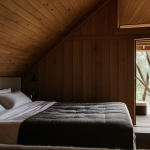Understanding Zen Principles
Zen principles have long been associated with creating spaces that promote tranquility and mindfulness in the home environment. At its core, Zen philosophy emphasizes simplicity, focusing on eliminating clutter to make room for calm and clarity. This approach can transform a chaotic space into a sanctuary of peace and relaxation.
A Zen-inspired environment leans heavily on natural materials and earthy color palettes. Integrating elements such as wood, stone, and natural fibers contributes to a sense of grounding and connection to the earth. These materials, combined with soft, neutral tones, create a serene atmosphere that nurtures the spirit. Simplicity is not just about removing excess items but also about selecting fewer, well-chosen pieces that align with your personal sense of peace and purpose.
Additional reading : How Can You Transform Small Spaces into Cozy Havens?
Incorporating mindfulness into design choices is essential. Mindful design involves intentionality, where each item and color is selected deliberately to support relaxation and focus. By prioritizing mindfulness, you ensure that your home environment serves as a refuge from life’s stresses, facilitating a deeper sense of tranquility.
To further embody these Zen principles, consider the layout and lighting of your space. Arranging furniture and decor in a manner that promotes unobstructed flow can enhance the feeling of openness and freedom. Thoughtfully placed lighting, particularly natural light, can also play a pivotal role in uplifting the mood and aesthetics of a Zen-inspired home.
Have you seen this : How Can You Enhance Your Home’s Style with DIY Projects?
Interior Design Tips for a Zen Atmosphere
Creating a Zen-inspired home environment calls for thoughtful interior design choices that foster tranquility. Soft, neutral colors play a crucial role in this regard, promoting a calm and serene atmosphere. Earthy tones like muted greens, soft browns, and cool blues complement natural light to enhance the feeling of peace. Integrating these colors in your home design helps establish a soothing backdrop for mindful living.
Color Schemes
Color schemes significantly impact the mood of your space. Aim for gentle, neutral palettes that provide a sense of peace and relaxation. Earth tones are excellent for fostering an organic ambiance, while subtle blues and greens can evoke calmness. Allowing natural light to permeate these hues further adds to the openness and serenity of the room, enhancing the overall perception of space.
Furniture Selection
When selecting furniture, focus on minimalistic and functional pieces that support fluid movement. Choose materials like wood and bamboo, which not only align with Zen aesthetics but also enhance tranquility. Decluttering is paramount; maintain an organized, clean space free from excess items. This simplicity in furniture design contributes significantly to the feeling of a Zen environment.
Calming Accessories
Complete your Zen interior with accessories that promote peace. Incorporate artworks and decor that align with the theme of calmness. To add warmth, use soft textiles and natural fibers. Finally, introduce elements like candles, essential oils, and calming scents to create a sensory experience that fosters relaxation and mindfulness, enhancing the overall ambiance of a Zen-inspired home.
Creating a Zen-Inspired Outdoor Space
Bringing tranquility outdoors, particularly through a Zen garden, enhances the serenity of your living space. Key elements include natural materials that echo those within a Zen home. Consider incorporating stones, sand, and wooden features to promote a calm ambiance. By embracing simplicity outside, you foster a continuous sense of peace that aligns with Zen principles.
Landscaping
Integrating nature into your exterior design ties the home environment to the outdoors. Plants such as bamboo and mosses often feature prominently in traditional Zen gardens. These species are not only pleasing to the eye but also require minimal maintenance, allowing you more time for relaxation.
Features of a Zen Garden
Creating a Zen garden in your backyard involves thoughtful use of elements like rocks and sand that mimic natural landscapes. Raked lines in the sand can represent water ripples, adding a contemplative element that encourages mindfulness. Strategic placement of stones can represent islands, contributing to an overall tranquil layout.
Nature and Tranquility
Plants play a significant role in an outdoor Zen space. Plants like lavender and jasmine not only fill the air with calming scents but also attract wildlife, enhancing the natural feel. Minimal pruning and care should be required, preserving the garden’s low-maintenance philosophy.
By integrating these features, your outdoor area can become a harmonious extension of your home’s Zen aesthetic, providing a seamless transition that underscores the importance of tranquility in daily living.
Mindfulness Practices at Home
Mindfulness practices can transform your home into a sanctuary of peace and reflection. Integrating these practices helps to elevate the tranquility of your living space, making it a perfect environment for relaxation and clarity.
Meditation Spaces
Creating a dedicated meditation space is key to enhancing mindfulness at home. It’s crucial to set aside a peaceful area where you can engage in quiet reflection. In this space, focus on calming elements such as serene lighting, which can be achieved with candles or soft lamps, and soundscapes that include gentle music or ambient nature sounds. Functional decor, like cushions and mats, can provide comfort and support. Incorporating daily practices like deep breathing and visualization exercises in this space can significantly enhance your well-being.
Incorporating Nature Sounds
Adding nature sounds to your home can have a profound effect on relaxation. The rhythmic sounds of waves or the rustling of leaves can create a soothing backdrop, enhancing the overall ambiance. Consider using sound machines or apps that provide a variety of natural soundscapes. Furthermore, integrating water features like a small fountain can add an auditory layer of serenity, offering continual lulling sounds that promote deep relaxation.
Color Psychology in Mindfulness
Colors play a powerful role in influencing mood and well-being. To foster mindfulness, it’s essential to consider how specific color schemes affect different areas of your home. Soft, muted tones such as pastels and earth tones are known to evoke peace and calmness. Use colors deliberately, tailoring each hue to suit personal preferences and the room’s purpose. Experimenting with shades can help find a palette that truly nurtures the mind and spirit, creating an environment conducive to mindfulness.
Resources and Inspiration
Exploring Zen inspiration starts with tapping into the right resources. A well-curated collection of websites and books can provide valuable insights into transforming your home into a tranquil retreat. Look for titles that delve into Zen principles, focusing on simplicity, mindfulness, and natural materials. These resources often offer practical advice, making them an excellent starting point for understanding the philosophy behind Zen design.
Connecting with communities that share an interest in Zen living can also be immensely rewarding. Online forums and social media groups dedicated to Zen and minimalist living provide spaces for exchanging ideas, sharing transformations, and gaining support on your journey towards creating a peaceful home environment. These platforms often feature before-and-after transformations from homes in the UK, showcasing the adaptability of Zen principles across various living spaces.
For those inclined towards hands-on projects, engaging in DIY initiatives can be a fulfilling way to infuse Zen elements into your living space. Whether crafting furniture from natural materials or creating simple decor items, DIY projects offer a personalized touch to your home. Identifying local suppliers or online stores that specialize in eco-friendly and minimalist supplies can be essential for these projects. Making small, meaningful changes in your space not only embodies Zen principles but also allows your personal style to shine.





